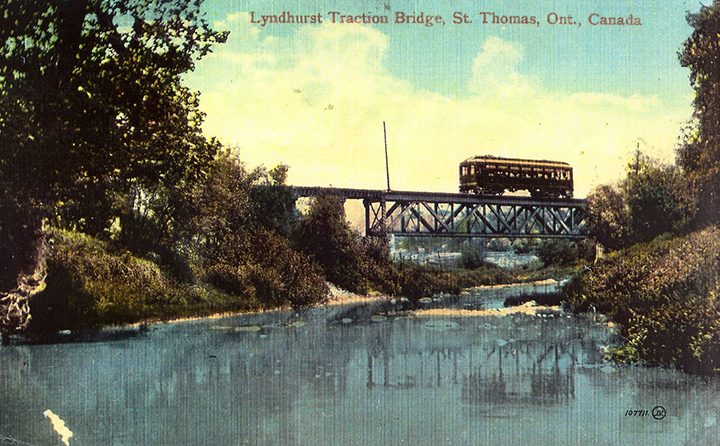Inducted 2012
In 1902 a group of London, Ontario residents led by Thomas Purdom and Alfred E. Welch chartered an electric railway based in London. Unlike the municipally- London & Port Stanley Railway, the South Western Traction Company was chartered primarily as a passenger hauling line. Lines were planned to several other municipalities in the area, including Woodstock, Delaware, Fingal, Aylmer and Sparta, but ultimately, the line was a 28-mile meandering route between London and Port Stanley. The line began construction in 1903 southward from London to Lambeth. Construction stopped in 1904 when the company ran out of funds. Additional capital was eventually secured from the Canadian Electric Traction Company of England and construction resumed. The generating equipment and rolling stock was supplied by Bruce Peebles & Co. Ltd. of Edinburgh, Scotland. The equipment on the Southern Western Traction Company was designed to use a three phase overhead designed by Ganz of Budapest, Hungary, and was the only railway in North America to do so.
The route of the line continued southward towards St. Thomas, passing through the villages o Scottsville, Tempo and Lynhurst. Tracks reached St. Thomas in July 1906. The Traction Line used the tracks of the St. Thomas Municipal Railway along Talbot Street to First Ave. The line entered town on the west end and exited southward on the east end, crossing over the London and Port Stanley Railway via the street railway on Talbot Street in the process. Continuing southward, the line passed through the village of Union and entered Port Stanley via Colborne Street. The Traction Line station was on the east side of Port Stanley harbour, compared to the more extensive L&PS yards on the side. The station was located directly off Colborne Street and still exists today. There was a spur line that ran behind the station down to the dock for loading fish and passengers. The line entered London via Baseline Road and curved north toward downtown. A long trestle carried the line over the Thames River valley before terminating at the company’s station on Horton Street.
There had been various issues with the Ganz A/C overhead system, and this prompted the line to switch to D/C operation in early 1907. The company ordered six D/C motor cars from the Ottawa Car Company in Ottawa, Ontario, in March 1907. The line was dealt a major blow on
August 10, 1907, when a fire caused by crossed wires destroyed the company’s car barns in London. The company’s six British built cars were in the barns at the time, and five were destroyed. Four of the new Ottawa cars were in St. Thomas, but hadn’t had their motors or equipment installed. The losses for the railway were pegged at over $160,000. The following year, six additional cars were purchased from Preston Car and Coach in Preston, Ontario. The first train arrived in Port Stanley in October 1907. Plans for expansions to Delaware and Aylmer, Ontario were looked at in 1907 as well, but for several reasons, these extensions were never built. The year 1908 brought about receivership and with it, a change in ownership.
In 1908, the South Western Traction Company was in receivership and was purchased at auction by J. MacDougall of London. A consortium of businessmen led by G.B Woods of Toronto purchased the line from Mr. MacDougall and formed the London and Lake Erie Railway and Navigation Company. The company prospered, with both freight and passenger revenues up. In 1911, the company was dealt another blow when Sunday service was suspended by the Province under the Lord’s Day Act. The London and Lake Erie, operating as a provincial charter, was not exempt from the act. Sunday cars were viewed as strictly recreational, and as the line did not provide an essential link, the company forced to discontinue Sunday service. This was not reinstated until 1913.
The company experimented with generating more freight service during this period. Fish from the dock in Port Stanley was the main commodity hauled, but never panned out into the big revenue generator the company hoped for. The tight curves and steep grades of the London and Lake Erie Railway, while satisfactory for interurban cars, were not conducive to effective freight operations. An interchange was established in St. Thomas around 1913 with the Michigan Central Railroad. Talks were held in Aylmer in 1915 as well, the company seriously looking at extending the line. The plan was to extend to Port Burwell via Aylmer, but that never came to pass.
In July, 1915, the London and Port Stanley Railway was electrified. That, combined with the ever growing threat of the automobile, eventually spelled the end for the London and Lake Erie Railway. By 1918, the London and Lake Erie Transportation Co. was two years behind in rent to the City of St. Thomas and in September of that year, Yarmouth Township seized rail equipment to support its demand for payment of back taxes. Service was discontinued on October 15, 1918.


